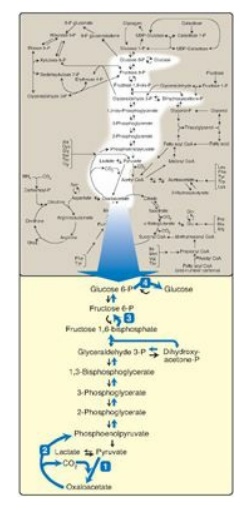Overview of Gluconeogenesis
| Home | | Biochemistry |Chapter: Biochemistry : Gluconeogenesis
Some tissues, such as the brain, red blood cells (RBCs), kidney medulla, lens and cornea of the eye, testes, and exercising muscle, require a continuous supply of glucose as a metabolic fuel.
Gluconeogenesis
OVERVIEW
Some tissues, such as
the brain, red blood cells (RBCs), kidney medulla, lens and cornea of the eye,
testes, and exercising muscle, require a continuous supply of glucose as a
metabolic fuel. Liver glycogen, an essential postprandial source of glucose,
can meet these needs for only 10–18 hours in the absence of dietary intake of
carbohydrate. During a prolonged fast, however, hepatic glycogen stores are
depleted, and glucose is formed from noncarbohydrate precursors such as
lactate, pyruvate, glycerol (derived from the backbone of triacylglycerols;), and
α-keto acids (derived from the catabolism of glucogenic amino acids;). The
formation of glucose does not occur by a simple reversal of glycolysis, because
the overall equilibrium of glycolysis strongly favors pyruvate formation.
Instead, glucose is synthesized by a special pathway, gluconeogenesis, which
requires both mitochondrial and cytosolic enzymes. During an overnight fast,
approximately 90% of gluconeogenesis occurs in the liver, with the remaining
10% occurring in the kidneys. However, during prolonged fasting, the kidneys
become major glucose-producing organs, contributing an estimated 40% of the
total glucose production. Figure 10.1 shows the relationship of gluconeogenesis
to other essential pathways of energy metabolism.

Figure 10.1 The
gluconeogenesis pathway shown as one of the essential pathways of energy
metabolism. The numbered reactions are unique to gluconeogenesis. (See Figure
8.2, for a more detailed map of metabolism.) P = phosphate.
Related Topics
